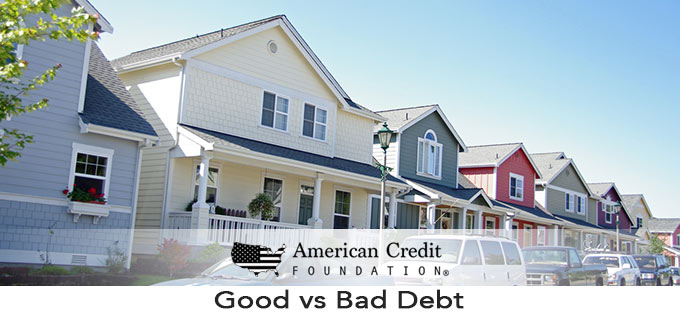
Good debt vs bad debt? Not all debt is created equal. In fact, some debt can make you more financially stable, while other types of debt can sink you further into a financial hole. If you’re looking to get your financial life in order, you must understand the difference between “good” debt and “bad” debt so you can make wise decisions. Debt can be good – or really, really bad.
Good vs Bad Debt: What’s in It for Me?
Any time you consider making a purchase using debt – whether it’s using a credit card, bank, or any other type of lender – you should first ask yourself whether the debt will work for you or against you. Robert Kiyosaki’s book Rich Dad Poor Dad sums up the philosophy perfectly: If the object you purchase with the debt doesn’t make you money or contribute to your financial future, it’s bad debt.
In other words, by looking at debt as a way to get ahead financially, you will improve your financial health. Here are some examples of good debt and bad debt. Use them to help plan for a healthy financial future.
Good Debt
While some people believe that having no debt at all is ideal, that’s not always the case. Some forms of debt can help grow your wealth and contribute to a sounder financial future.
Buying Real Estate
Most people take out a loan to purchase a home, and while the loan can be large, it still falls under the category of good debt. Why? Because historically, real estate appreciates, which increases your net worth. For instance, if you purchase a house for $100,000 and ten years later it’s worth $120,000, that $20,000 in appreciation is considered part of your net worth. And if you sell the house, you’ve just earned $20,000.
In addition to using debt to purchase a personal home, many people use debt to purchase real estate for rentals. For example, if you purchase a rental home and the mortgage is $1,000 but you rent it for $1500, that debt is earning money for you.
Opening a Business
If you want to build your financial future, working for yourself is a great way to do it. But many people need to take out a loan to launch their business. While opening any new business is a risk, this type of debt can still be considered good debt because of the potential financial earnings. But to ensure that business debt will be a win for you, be sure to do your due diligence before borrowing for your business to ensure your best chances of success.
Getting an Education
People who have a useful degree typically earn more than those who don’t, and that’s why educational debt can be considered good debt. But this isn’t true in all cases. There are many types of degrees, and not all of them will lead to a high-paying career. To judge whether or not educational debt is right for you, research your potential salary. Will it be enough to pay off the debt within a year? If not, either consider another degree or skip this type of debt.
Bad Debt
Now that we’ve learned what types of debt are considered good, let’s take a look at the types of debt that you should avoid. These debt types cause you to make purchases that depreciate rather than help put more money in your pocket. In other words, they drain you financially instead of building your portfolio.
Buying Clothes and Household Goods

It can be tempting to put that new wardrobe or that pair of dining room draperies on your credit card. But consider this: If you charge those items, you will pay many times more than the price tag. For instance, if you spend $1,500 on clothes using a credit card that charges 25% interest and pay the minimum payment ($35), it will take you nine years and one month to pay them off – and your total payments will equal $2,291.39. That means you will actually pay $791.39 more for those clothes than they cost. Can you see how using debt to purchase items that don’t appreciate can negatively affect your financial health?
Purchasing a Car
Did you know that when you buy a new car and drive it off the lot, it instantly depreciates? It’s true: The car is worth less one minute after you drive it off the lot than it was when you bought it. That depreciation is what makes car debt fall into the bad debt category.
Rather than making this type of bad debt purchase, think about alternative ways to buy a car. You can save the cash and buy a car outright, or if you can’t do that, at least look for an interest-free loan that won’t add to the total cost of the car. Many dealerships offer these types of loans as promotions to get customers in the door.
Getting a Payday Loan
One of the worst types of bad debt is payday loans. People typically use these types of loans in an emergency or when they need some extra cash to make it to their next payday. But there is a catch – a huge one. The annual interest rates on these loans can top 400%. You read that correctly: four hundred percent! In other words, if you borrow $500, you can expect to pay $75 to $150 per week in interest until it’s paid off. No wonder people who take out these loans constantly need to take out a new loan to pay off the old one!
As the master of your financial future, you have the ability to decide which type of debt you will accept. Will you use it to enhance your future or will you use it to put a drain on your finances? If you need help determining whether you’ve got good vs bad debt and which type of debt will best serve you, reach out to the friendly folks at American Credit Foundation. They will look at your unique situation and help you decide on the best course of action.